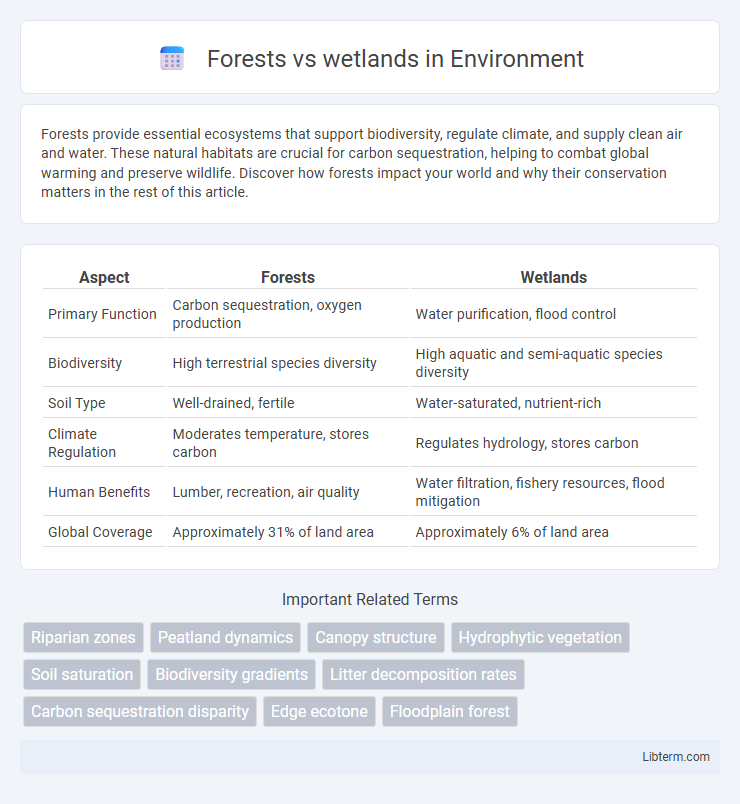Forests provide essential ecosystems that support biodiversity, regulate climate, and supply clean air and water. These natural habitats are crucial for carbon sequestration, helping to combat global warming and preserve wildlife. Discover how forests impact your world and why their conservation matters in the rest of this article.
Table of Comparison
| Aspect | Forests | Wetlands |
|---|---|---|
| Primary Function | Carbon sequestration, oxygen production | Water purification, flood control |
| Biodiversity | High terrestrial species diversity | High aquatic and semi-aquatic species diversity |
| Soil Type | Well-drained, fertile | Water-saturated, nutrient-rich |
| Climate Regulation | Moderates temperature, stores carbon | Regulates hydrology, stores carbon |
| Human Benefits | Lumber, recreation, air quality | Water filtration, fishery resources, flood mitigation |
| Global Coverage | Approximately 31% of land area | Approximately 6% of land area |
Introduction: Understanding Forests and Wetlands
Forests comprise dense collections of trees and understory vegetation that support rich biodiversity and regulate climate by sequestering carbon dioxide. Wetlands are areas where water saturates the soil, creating unique habitats that filter pollutants, store floodwaters, and sustain diverse aquatic plants and wildlife. Both ecosystems play vital roles in environmental stability, nutrient cycling, and providing ecosystem services essential for human well-being.
Key Characteristics of Forests
Forests are characterized by a dense aggregation of trees covering a large area, typically dominated by woody vegetation and diverse plant species that create multilayered canopies. They provide critical habitats for terrestrial wildlife, regulate climate through carbon sequestration, and influence water cycles by intercepting rainfall and facilitating groundwater recharge. Forest ecosystems support biodiversity, maintain soil structure, and act as natural carbon sinks, distinguishing them from wetlands that are primarily saturated with water and dominated by hydrophilic vegetation.
Key Characteristics of Wetlands
Wetlands are characterized by saturated soils, standing water for at least part of the year, and unique hydrophytic vegetation adapted to moist conditions. Unlike forests, wetlands support diverse aquatic plants, including sedges and cattails, and play a critical role in water filtration, flood control, and carbon sequestration. Key types of wetlands include marshes, swamps, bogs, and fens, each with distinct hydrology, soil types, and plant communities.
Biodiversity in Forests vs Wetlands
Forests harbor diverse ecosystems with towering trees, understory plants, and countless animal species, creating complex habitats that support high biodiversity. Wetlands provide unique environments rich in aquatic plants, amphibians, migratory birds, and specialized insects, playing a crucial role in maintaining ecological balance and water purification. The biodiversity in forests and wetlands complements each other, with forests promoting terrestrial life forms and wetlands sustaining aquatic and semi-aquatic species, both vital for global ecological health.
Ecosystem Services Provided by Forests
Forests provide critical ecosystem services including carbon sequestration, biodiversity habitat, water regulation, and soil stabilization, supporting overall environmental health and human well-being. They act as natural water filters, reducing pollution and maintaining clean water supplies while also mitigating climate change through significant carbon storage in biomass. Forest ecosystems enhance air quality by absorbing pollutants and provide essential resources such as timber and non-timber products, contributing to sustainable livelihoods.
Ecosystem Services Provided by Wetlands
Wetlands provide critical ecosystem services including water purification, flood control, and carbon sequestration. These habitats filter pollutants and excess nutrients from water, improving water quality and supporting biodiversity. Their ability to store large amounts of carbon helps mitigate climate change more effectively per hectare than many forests.
Role in Climate Regulation: Carbon Sequestration
Forests store approximately 80% of terrestrial above-ground carbon, making them critical carbon sinks that mitigate climate change. Wetlands, though covering less land area, sequester carbon in waterlogged soils, trapping organic matter and preventing carbon release. Together, these ecosystems regulate atmospheric CO2 levels, with forests sequestering carbon primarily in biomass and wetlands in peat and sediment layers.
Threats and Conservation Challenges
Forests face threats from deforestation, illegal logging, and habitat fragmentation, which reduce biodiversity and disrupt carbon storage. Wetlands are threatened by drainage for agriculture, pollution, and invasive species that degrade water quality and habitat integrity. Conservation challenges for both ecosystems include balancing human development needs with ecosystem preservation and implementing effective restoration and protection policies.
Human Impacts and Land Use Differences
Human impacts on forests primarily involve deforestation for agriculture, urban development, and logging, which leads to habitat loss and carbon release. In contrast, wetlands face drainage and land reclamation for farming and construction, severely reducing biodiversity and water filtration functions. Land use differences highlight forests as sources of timber and carbon sinks, whereas wetlands are crucial for flood control, water purification, and supporting unique ecosystems.
Conclusion: Balancing Protection and Sustainable Use
Forests and wetlands both play critical roles in biodiversity conservation, carbon sequestration, and ecosystem services, demanding tailored strategies for their protection and sustainable use. Effective management requires balancing preservation efforts with sustainable resource extraction to maintain ecological integrity while supporting local livelihoods. Integrating community engagement, scientific monitoring, and adaptive policies ensures long-term resilience and health of these vital ecosystems.
Forests Infographic

 libterm.com
libterm.com